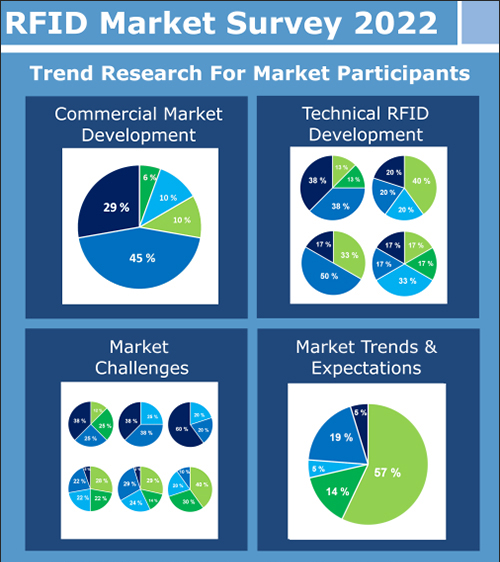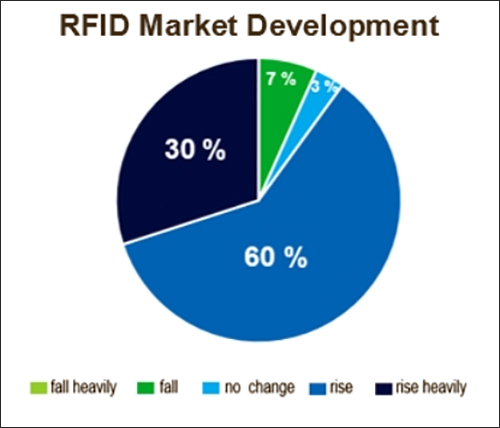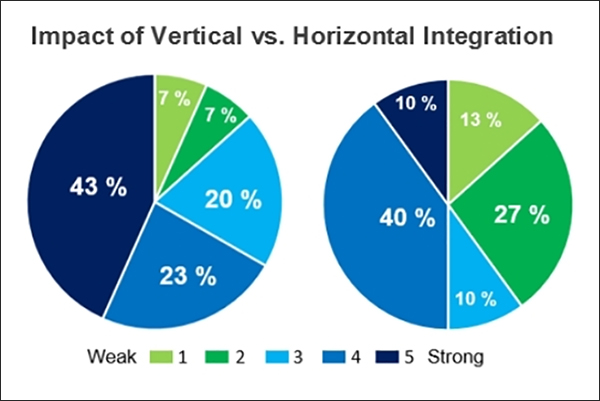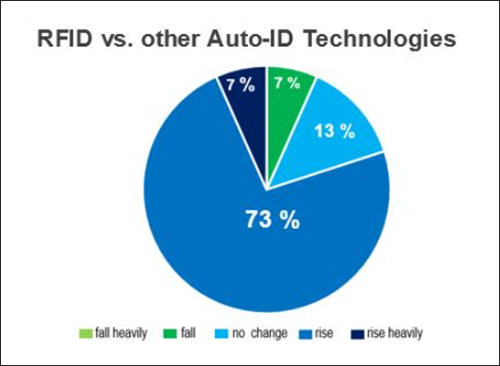- RFID Trends Advice from Industry Leaders
- Chip Shortage Forecast to End in 2024
- Almanac Delivers More Accessible Details
 Despite global economic and energy challenges, the mood among those in the radio frequency identification industry is good. Companies providing RFID technology and solutions experienced 20 to 30 percent growth in the past year, and most expect to see more of the same going forward. That growth has occurred despite a worldwide chip shortage that is expected to ease in 2024, according to a new European EPC Competence Center (EECC) report titled “RFID Market Survey,” the first of its kind from the RFID innovation center
Despite global economic and energy challenges, the mood among those in the radio frequency identification industry is good. Companies providing RFID technology and solutions experienced 20 to 30 percent growth in the past year, and most expect to see more of the same going forward. That growth has occurred despite a worldwide chip shortage that is expected to ease in 2024, according to a new European EPC Competence Center (EECC) report titled “RFID Market Survey,” the first of its kind from the RFID innovation center

Conrad von Bonin
According to the EECC, the survey resulted from interviews with RFID companies’ chief-level leadership. The report was released along with the organization’s latest “EECC UHF RFID Almanac” and is available for sale on the EECC’s website. The market survey, also available in digital format, is based on the impressions of approximately 30 industry leaders. The report provides a structured, transparent and objective way to review the RFID industry, according to Conrad von Bonin, the EECC’s CEO. It does so in six chapters and a total of 42 pages covering long-term market and price trends. The research also examines relevant issues, such as chip shortages, the U.S. and China conflicts, and the overall outlook.
In addition to its RFID market survey, EECC has also released its annual “UHF RFID Almanac.” This year, the almanac provides details about 621 RFID transponders and 45 readers, according to a variety of parameters and processes. The updated almanac also includes a set of guidelines specific to applications and industries, such as healthcare or logistics, and is the latest in a report that EECC has released for the past 16 years. The industry testing center was founded by GS1 Germany, Deutsche Post, DHL and Metro Group to provide a standardized approach for the adoption of the Electronic Product Code (EPC) and the network EPC Information Services (EPCIS) software in 2004.
RFID Trends Advice from Industry Leaders
 As the EECC’s CEO, von Bonin has been solicited for advice about RFID trends throughout the years, and most recently for his views about chip shortages and other disrupting factors, as well as his expectations for the industry in the coming years. “I have always been in the role of giving advice,” he says, “but, of course, it was only the advice of me and not all the people [in the industry].” So this year, the organization opted to reach out to leadership among the members of the EECC community. It chose to speak with 30 individuals, most of whom were C-level management at RFID companies, as well as representatives of industry associations fully responsible for decision making.
As the EECC’s CEO, von Bonin has been solicited for advice about RFID trends throughout the years, and most recently for his views about chip shortages and other disrupting factors, as well as his expectations for the industry in the coming years. “I have always been in the role of giving advice,” he says, “but, of course, it was only the advice of me and not all the people [in the industry].” So this year, the organization opted to reach out to leadership among the members of the EECC community. It chose to speak with 30 individuals, most of whom were C-level management at RFID companies, as well as representatives of industry associations fully responsible for decision making.
Participants were asked 30 questions related to trends, technology development, challenges ahead and their professional outlook. Ninety percent of interviewees said they expect the RFID marketing to rise or rise heavily, while just 7 percent expect it to fall. The majority (66 percent) foresee a rise in the sales of RFID labels across all company sizes. Customer-specific RFID label sales are expected to rise, according to 86 percent of respondents. However, a much smaller percentage anticipate the price declining in the label market, which poses a challenge ahead for those seeking low-cost deployments.
The survey finds that RFID plays a major role in a more crowded IoT or automatic-identification market, while 7 percent of respondents voted for other technologies. RFID will not replace barcodes, the report indicates, while technologies such as active auto-ID systems—for example, computer vision—are expected to grow as well. Overall, von Bonin reports, the results were highly optimistic. Despite crises in commercial markets, including Europe’s energy challenges due to the Russian-Ukraine war, the U.S. and China economic standoff and chip shortages, RFID sales are still rising.
Chip Shortage Forecast to End in 2024
 Nearly all of those surveyed expect the chip shortage to be resolved by 2025, with the vast majority predicting chip quantities will rise to meet demand in 2024. Von Bonin notes that prices are unlikely to come down, since the need for more chips will continue to exceed supply. While RFID chip production is still dominated by two manufacturers, Impinj and NXP Semiconductors, other players in Asia may have an impact in the coming years. But while numerous Chinese companies are developing RFID chips and inlays, performance still may require several more years to compete with the quality of chips and tags from existing businesses.
Nearly all of those surveyed expect the chip shortage to be resolved by 2025, with the vast majority predicting chip quantities will rise to meet demand in 2024. Von Bonin notes that prices are unlikely to come down, since the need for more chips will continue to exceed supply. While RFID chip production is still dominated by two manufacturers, Impinj and NXP Semiconductors, other players in Asia may have an impact in the coming years. But while numerous Chinese companies are developing RFID chips and inlays, performance still may require several more years to compete with the quality of chips and tags from existing businesses.
Many participants agreed that the U.S.-China conflict is having a negative impact on the chip and RFID industry, especially for converters and systems integrators, and particularly among small and medium-sized companies. What’s more, the survey finds that big companies will dominate the RFID market, something both small and large businesses agree on. Further cooperation between companies and consolidations is expected by those surveyed. The survey is intended to benefit those already in the RFID industry, as well as those expecting to use RFID or to invest in the market.
Overall, von Bonin says, “It’s an astonishing outlook,” since many other technology sectors have more conservative expectations. Optimism for the technology crosses vertical markets, he adds, from the automotive industry to the textiles sector. “RFID is really seen as the most important auto-ID technology.” While it will not replace the barcode, he says, “It will be a complementation to the barcode.”
Almanac Delivers More Accessible Details
 A version of the EECC’s annual almanac was first released in 2007 under the name “UHF Tag Performance Survey (UTPS)” (see EECC Study Finds Growth in UHF Tag Volume, Variety) This has since grown to include an increasing number of tags and readers, such as on-metal transponders and the performance testing of tags certified for specific applications. Sensitivity to interference as characterized by various reader signals was added in 2015, and a year later, sensor functionalities were analyzed for the first time, while memory was added to the test’s categories, along with untraceable commands.
A version of the EECC’s annual almanac was first released in 2007 under the name “UHF Tag Performance Survey (UTPS)” (see EECC Study Finds Growth in UHF Tag Volume, Variety) This has since grown to include an increasing number of tags and readers, such as on-metal transponders and the performance testing of tags certified for specific applications. Sensitivity to interference as characterized by various reader signals was added in 2015, and a year later, sensor functionalities were analyzed for the first time, while memory was added to the test’s categories, along with untraceable commands.
In 2020, the EECC revised the survey’s ease of use for readers. For the first time, tags were categorized according to their application areas, while detailed explanations of measurements for practical use cases were added. Last year, handheld and fixed RFID readers were also measured and categorized for the first time, in addition to transponders, and the influence on readers’ overall performance with transponders is now included as well. With this extension, the organization indicates, the study is now published under the title “EECC UHF RFID Almanac.”
The almanac provides a technical review of the performance of tags and readers, and it divides the tested products into the sectors in which they best perform. This year, users can leverage the document to look up the performance of technologies specific to their sector and application. For instance, there are categories dedicated to use by the healthcare, industrial, laundry, retail and logistics sectors, enabling users to evaluate the performance and pricing of transponders and readers. “We hope that that details like these graphs make it easier to consume,” von Bonin states.
Images: European EPC Competence Center
Key Takeaways:
- The EECC’s new survey, conducted via interviews of 30 leaders in the RFID industry, has found that technology sales are increasing at a rate of 20 to 30 percent.
- This positive outlook comes with some challenges, which include the chip shortage forecast to last until 2024, as well as low expectation that label prices will drop any time soon.


